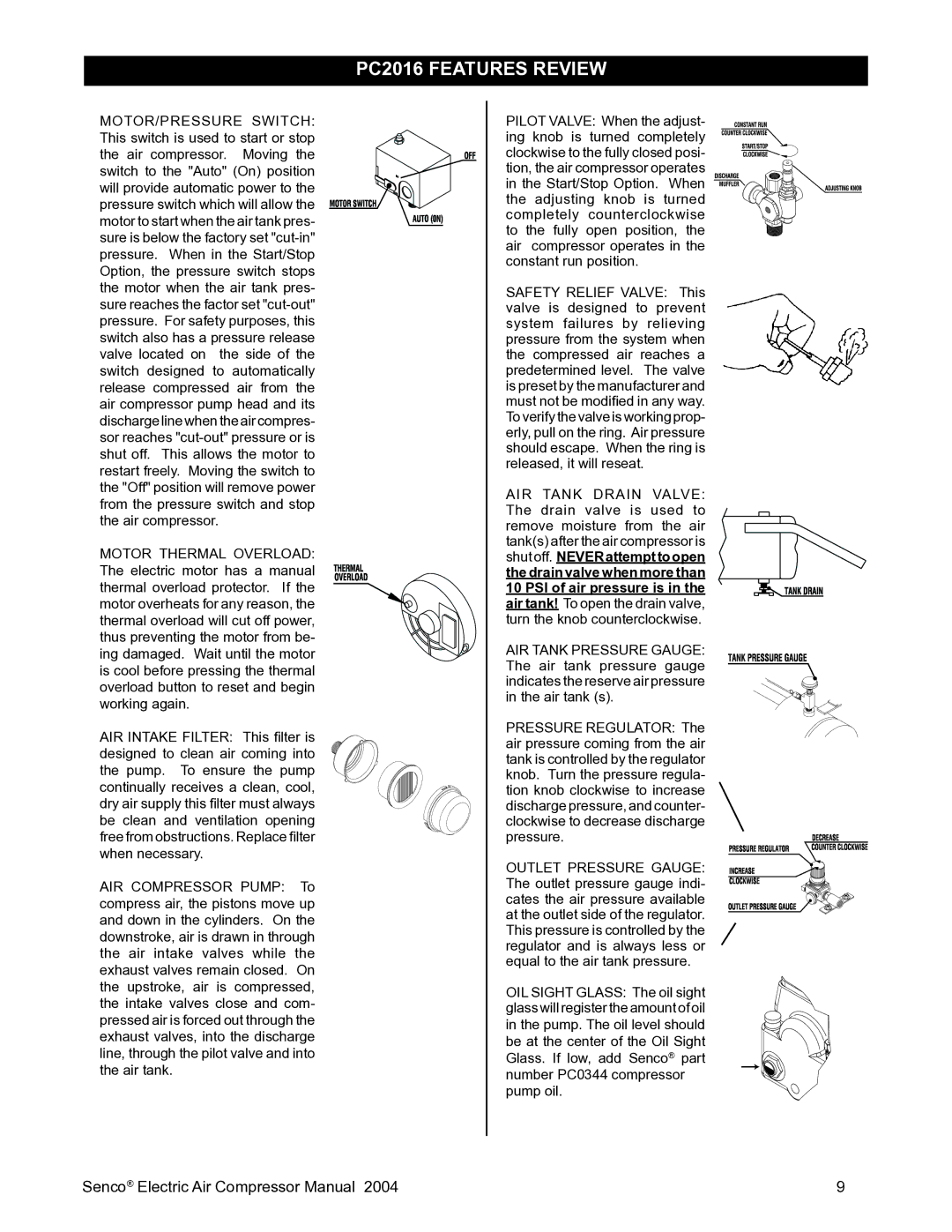
PC2016 FEATURES REVIEW
MOTOR/PRESSURE SWITCH: This switch is used to start or stop the air compressor. Moving the switch to the "Auto" (On) position will provide automatic power to the pressure switch which will allow the motor to start when the air tank pres- sure is below the factory set
MOTOR THERMAL OVERLOAD: The electric motor has a manual thermal overload protector. If the motor overheats for any reason, the thermal overload will cut off power, thus preventing the motor from be- ing damaged. Wait until the motor is cool before pressing the thermal overload button to reset and begin working again.
AIR INTAKE FILTER: This filter is designed to clean air coming into the pump. To ensure the pump continually receives a clean, cool, dry air supply this filter must always be clean and ventilation opening free from obstructions. Replace filter when necessary.
AIR COMPRESSOR PUMP: To compress air, the pistons move up and down in the cylinders. On the downstroke, air is drawn in through the air intake valves while the exhaust valves remain closed. On the upstroke, air is compressed, the intake valves close and com- pressed air is forced out through the exhaust valves, into the discharge line, through the pilot valve and into the air tank.
PILOT VALVE: When the adjust- ing knob is turned completely clockwise to the fully closed posi- tion, the air compressor operates in the Start/Stop Option. When the adjusting knob is turned completely counterclockwise to the fully open position, the air compressor operates in the constant run position.
SAFETY RELIEF VALVE: This valve is designed to prevent system failures by relieving pressure from the system when the compressed air reaches a predetermined level. The valve is preset by the manufacturer and must not be modified in any way. To verify the valve is working prop- erly, pull on the ring. Air pressure should escape. When the ring is released, it will reseat.
AIR TANK DRAIN VALVE: The drain valve is used to remove moisture from the air tank(s) after the air compressor is shut off. NEVER attempt to open the drain valve when more than 10 PSI of air pressure is in the air tank! To open the drain valve, turn the knob counterclockwise.
AIR TANK PRESSURE GAUGE: The air tank pressure gauge indicates the reserve air pressure in the air tank (s).
PRESSURE REGULATOR: The air pressure coming from the air tank is controlled by the regulator knob. Turn the pressure regula- tion knob clockwise to increase discharge pressure, and counter- clockwise to decrease discharge pressure.
OUTLET PRESSURE GAUGE: The outlet pressure gauge indi- cates the air pressure available at the outlet side of the regulator. This pressure is controlled by the regulator and is always less or equal to the air tank pressure.
OIL SIGHT GLASS: The oil sight glass will register the amount of oil in the pump. The oil level should be at the center of the Oil Sight Glass. If low, add Senco® part number PC0344 compressor pump oil.
Senco® Electric Air Compressor Manual 2004 | 9 |
